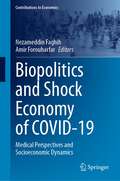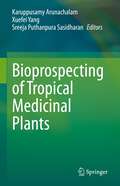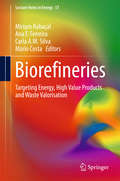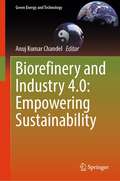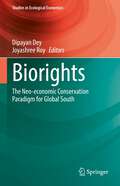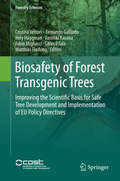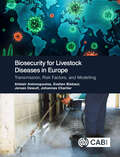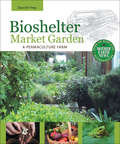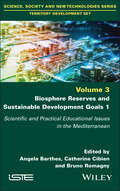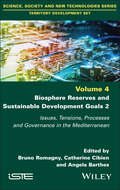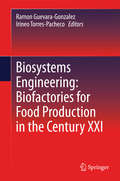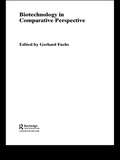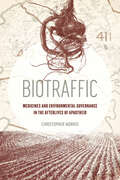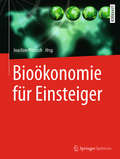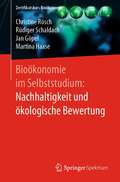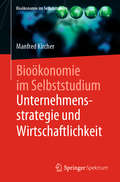- Table View
- List View
Biophysical Economy: Theory, Challenges, and Sustainability (Applied Ecology and Environmental Management)
by Steven M. BartellThis book explores the concept of transforming the current macroeconomic system from one based on continuous growth that doesn’t recognize the fundamental importance of Earth's natural support structures, to a system consistent with the basic views of biophysical economics that acknowledges that all real wealth ultimately derives from planetary resources, both renewable and non-renewable. It describes how data and information collected by various institutions, government agencies, and the private sector can be integrated with existing management structures to transform the “continuous growth” economy into an economy that functions within understandable boundaries on a finite planet. Features Stimulates discussions of the feasibility of a biophysical economy. Discusses the historical developments of biophysical economics. Offers a practical approach to building a biophysical economy. Explores the human experience of living in a biophysical economy. Emphasizes the fragility of life in the Universe as we know it. This book is an excellent resource for academics and students studying sustainable development, as well as for professionals working in the private sector and public institutions with an interest in economic planning for a sustainable future.
Biopolitical Imperialism
by M. G. KellyBiopolitical Imperialism is a book about international politics today. The core, eponymous thesis is that our world is marked by a pattern of biopolitical parasitism, that is, the enhancement of the life of wealthy populations of First World countries on the basis of an active denigration of the lives of the poor mass of humanity. The book details how this dynamic plays out both inside wealthy countries and internationally.
Biopolitics and Shock Economy of COVID-19: Medical Perspectives and Socioeconomic Dynamics (Contributions to Economics)
by Nezameddin Faghih Amir ForouharfarThis edited volume discusses the biopolitics and shock economy of COVID-19, emphasizing medical perspectives and the socioeconomic dynamics of the pandemic and the ensuing institutional responses. Written by an international, multidisciplinary group of academic and professional experts, chapters embrace a wide range of topics such as: medical perspectives on COVID-19; application of geospatial technology; infectivity, immunogenicity, and disease as important factors for adoption of relevant biopolitical measures; shock economy; COVID-19-induced transaction costs; social support and resilience of inhabitants of marginalized areas; business resilience factors; entrepreneurship; and digital transformation. Jointly addressing global examples of biopolitical governance and overarching macroeconomic effects of the pandemic, this volume will be of interest to academics across disciplines as well as policymakers and practitioners on the ground.
Bioprospecting of Tropical Medicinal Plants
by Xuefei Yang Karuppusamy Arunachalam Sreeja Puthanpura SasidharanThis book focuses on natural products, in particular medicinal plants and their derived products, as an indispensable source of bioactive molecules that serve as either drug candidates or lead compounds for drug design and discovery . There are several advantages for plant-derived therapeutics, including wide availability, diverse pharmacological actions, and a generally good profile of safety and tolerability. Over the recent years, there have been numerous reports from clinical studies testifying the efficacy and safety of medicinal plants and phytochemicals in treating human diseases. A plethora of basic studies has also unraveled molecular mechanisms underlying the health benefits of herbal medicines. Nevertheless, issues such as identification of bioactive ingredients, standardization of the products, and drug interactions remain to be systematically documented. Bioprospecting of Tropical Medicinal Plants represents a comprehensive analysis of natural products, mainly medicinal plants and phytochemicals. It includes detailed medicinal properties and pharmacological action from in vitro models to clinical trials. The goal is to present the readers a carefully curated collection of plant-derived natural products and their underlying molecular mechanisms.
Biopure Corp.
by John T. GourvilleIt is early 1998 and Biopure Corp., a small biopharmaceutical firm with no sales revenues in its ten-year history, has just received government approval to release Oxyglobin, a revolutionary new "blood substitute" designed to replace the need for donated animal blood in the veterinary market. A virtually identical product for the human market, Hemopure, is in the final stages of testing by Biopure and is expected to gain approval within one to two years. In response to the timing of approval for these two products, there has been a long-running debate within Biopure as how to proceed with Oxyglobin. At odds are those in charge of Oxyglobin, who want to see the animal product released immediately, and those in charge of the Hemopure, who worry that an immediate release of Oxyglobin would create an unrealistically low price expectation for what they feel should be a very high-margin human product. Exacerbating the problem is the nature of the biopharmaceutical industry, where product approval is never a certainty until achieved.
Biorefineries
by Miriam Rabaçal Ana F. Ferreira Mário Costa Carla A. SilvaThis book addresses the potential of the transformation of biomass into a wide range of marketable products, and examines the biological, biochemical, physical and thermal processing of biomass into products such as fuels, power, heat, feeds, chemicals and materials. Respective chapters explore various topics including biomass characterization, biomass pre-conditioning and sustainability analysis, aspects that are supplemented by a global overview of their implementation in current pilot bio-refineries. Providing a valuable resource to energy engineers, chemical engineers, biotechnologists and economists, this book will also be of great interest to students and policymakers.
Biorefinery and Industry 4.0: Empowering Sustainability (Green Energy and Technology)
by Anuj Kumar ChandelThis book provides a comprehensive overview of the latest advances in the production of low carbon chemicals and biofuels from renewable feedstock, including pilot, demo, and commercial-scale technologies. It highlights the role of Industry 4.0 in improving the efficiency and affordability of biorefineries, ultimately leading to the production of bio-based molecules and energy with low carbon and water footprints. Drawing on the expertise of established researchers, academics, and engineers, the book presents a range of informative chapters on the subject. It explores the key elements of Industry 4.0, such as, interconnectivity and smart process automation, and shows how these can be harnessed to revolutionize industrial processes and offer finished products in a cost-effective manner. With its emphasis on sustainability and cutting-edge technology, this book is an essential resource for anyone interested in the future of low carbon chemistry and bioenergy production.
Biorights: The Neo-economic Conservation Paradigm for Global South (Studies in Ecological Economics #7)
by Joyashree Roy Dipayan DeyThis book evaluates local conservation successes of global south in the climate milieu, as an empirical evidence of ‘Bio-rights’ of commons at community-ecosystem interface for sustainable intensification of nature’s goods and services. Bio-rights is a right-based neo-economic conservation paradigm that compensates the opportunity costs incurred in conservation efforts by the marginal communities, living near globally important ecosystems and dependent on it for their livelihood, through payments from environment services. The book would bring forth the true value of circular economic interventions in socio-ecological conservation, shaped through sustainable human interactions with nature. This multilevel study of conservation science serves an interdisciplinary academia, consistent with conventions on climate change, bio-diversity and sustainable development, to establish links between conservation priorities and development objectives. Herein, Bio-rights is introduced as a ‘design approach’ for production linked sustainable development, supplemented with case studies from the east.
Biosafety of Forest Transgenic Trees: Improving the Scientific Basis for Safe Tree Development and Implementation of EU Policy Directives (Forestry Sciences #82)
by Cristina Vettori Fernando Gallardo Hely Häggman Vassiliki Kazana Fabio Migliacci Gilles Pilate Matthias FladungThis book provides up-to-date information on the environmental impact of transgenic trees on genetically modified tree (GMT) communication strategy. It is useful to public/private organisations as well as to private and public research bodies and universities worldwide since it reports on the global status of GMT research and policy. A high number of genetically modified trees (GMTs) with altered or novel characteristics have been produced in the last 15 years. However, their very low public acceptance is a basic problem in their commercialization. Breeders anticipate economic and ecological benefits, like reduced product costs and less pressure on native forests, while opponents fear risks, such as unintended spread of GMTs. But what is true? To answer this question, the COST Action FP0905 focused on key aspects related to GMTs: (a) biological characterization; (b) assessment of possible environmental impacts; (c) socio-economic implications and public acceptance/concerns; (d) providing science-based information to communicate with the public.
Biosecurity for Livestock Diseases in Europe: Transmission, Risk Factors, and Modelling
by Jeroen Dewulf Dr Alistair Antonopoulos Evelien Biebaut Johannes CharlierBiosecurity practices can help prevent the introduction and spread of disease, promoting better animal health and welfare, human health, food safety, and the economic benefits of livestock production. Stemming from a joint initiative between the Biosecure project which brought together 17 partners across 12 European countries, and DISCONTOOLS, the research gap database in animal health, this book provides valuable background information which can help to better understand and prioritize biosecurity measures. Driven by an evidence-based and cost-effective approach to biosecurity, it is divided into two sections covering endemic diseases typically present within most countries, and epidemic diseases with the potential for large scale outbreaks. Through a series of disease entries, it: - introduces the diseases of most relevance for the European context; - reviews our current understanding of biosecurity throughout the livestock production chain, and across the principal terrestrial animal species farmed within Europe: poultry, swine, cattle, and small ruminants; - covers the prevalence, risk factors, transmission routes, current control measures and biosecurity, and data for transmission modelling for each disease. By summarizing current knowledge on a range of diseases, this book forms both a useful resource for researchers and professionals in animal disease prevention, and a starting off point for identifying information gaps and requirements for future research.
Bioshelter Market Garden: A Permaculture Farm (Mother Earth News Books for Wiser Living)
by Darrell Frey&“This well-illustrated case study . . . will help students of permaculture, of sustainability, of earth regeneration and of integrated eco-social design.&” —Prof. Declan Kennedy, Chairman, Advisory Board, gaiauniversity.org To ensure food security and restore the health of the planet, we need to move beyond industrial agriculture and return to the practice of small-scale, local farming. The Bioshelter Market Garden: A Permaculture Farm describes the creation of a sustainable food system through a detailed case study of the successful year-round organic market garden and permaculture design at Pennsylvania&’s Three Sisters Farm. At the heart of Three Sisters is its bioshelter—a solar greenhouse which integrates growing facilities, poultry housing, a potting room, storage, kitchen facilities, compost bins, a reference library and classroom area. The Bioshelter Market Garden examines how the bioshelter promotes greater biodiversity and is an energy efficient method of extending crop production through Pennsylvania&’s cold winter months. Both visionary and practical, this fully illustrated book contains a wealth of information on the application of permaculture principles. Some of the topics covered include: Design and management of an intensive market garden farmEnergy systems and bio-thermal resourcesEcological soil management and pest controlWetlands usageSolar greenhouse design and management Whatever your gardening experience and ambitions, this comprehensive manual is sure to inform and inspire.&“Darrell Frey&’s inspirational book gives you all you need to know to create an energy-saving, food-producing bioshelter . . . [It] covers everything you need to understand, build, or simply admire these important tools for sustainability.&” —Toby Hemenway, author of Gaia&’s Garden
Biosphere Reserves and Sustainable Development Goals 1: Scientific and Practical Educational Issues in the Mediterranean
by Angela Barthes Bruno Romagny Catherine CibienSince 1971, UNESCO's Man and the Biosphere (MAB) Programme has embraced a number of principles that link the political, scientific and academic spheres. Biosphere Reserves and Sustainable Development Goals 1 presents these areas as privileged spaces for experimenting with operating methods specific to cross-cutting objectives and issues. These areas encourage the development of interdisciplinary research, supported by a worldwide network to disseminate experience, approaches and knowhow. The various global and local political scales are linked here, with different consequences for the reconfiguration of local political arenas, for specific modes of development linked to a renewed relationship with knowledge, powers and institutions, and for renewed relationships between the worlds of science, education and territorial governance.
Biosphere Reserves and Sustainable Development Goals 2: Issues, Tensions, Processes and Governance in the Mediterranean
by Angela Barthes Bruno Romagny Catherine CibienSince 1971, UNESCO's Man and the Biosphere (MAB) Programme has embraced a number of principles that link the political, scientific and academic spheres. Biosphere Reserves and Sustainable Development Goals 2 is a reminder of the fundamental issues involved in governance. The diversity and multiplicity of stakeholders, and the complexity of the interplay between them, as well as their organization, are decisive factors in the proper management of resources and territories. The book also presents a number of case studies demonstrating that, between the strong development aspirations of their populations, the impact of human activities and the need to conserve their biological heritage, the biosphere reserves of the southern Mediterranean are facing major issues: agricultural pollution, forest fires, water use in a context of climate change, etc.
Biosystems Engineering: Biofactories For Food Production In The Century Xxi (Advances In Biochemical Engineering & Biotechnology Ser. #Vol. 139)
by Ramon Guevara-Gonzalez Irineo Torres-PachecoThis book presents new food production systems (for plants and animals) involving agrochemicals that increase in a controlled manner the bioactives content, under greenhouse conditions. Moreover, conception and design of new instrumentation for precision agriculture and aquiculture contributing in food production is also highlighted in this book.
Biotechnology and Agricultural Development: Transgenic Cotton, Rural Institutions and Resource-poor Farmers (Routledge Explorations in Environmental Economics)
by Robert TrippThis book addresses the continuing controversy over the potential impact of genetically modified (GM) crops in developing countries. Supporters of the technology claim it offers one of the best hopes for increasing agricultural production and reducing rural poverty, while opponents see it as an untested intervention that will bring corporate control of peasant farming. The book examines the issues by reviewing the experience of GM, insect-resistant cotton, the most widely grown GM crop in developing countries. The book begins with an introduction to agricultural biotechnology, a brief examination of the history of cotton production technology (and the institutions required to support that technology), and a thorough review of the literature on the agronomic performance of GM cotton. It then provides a review of the economic and institutional outcomes of GM cotton during the first decade of its use. The core of the book is four country case studies based on original fieldwork in the principal developing countries growing GM cotton (China, India, South Africa and Colombia). The book concludes with a summary of the experience to date and implications for the future of GM crops in developing countries. This review challenges those who have predicted technological failure by describing instances in which GM cotton has proven useful and has been enthusiastically taken up by smallholders. But it also challenges those who claim that biotechnology can take the lead in agricultural development by examining the precarious institutional basis on which these hopes rest in most countries. The analysis shows how biotechnology’s potential contribution to agricultural development must be seen as a part of (and often secondary to) more fundamental policy change. The book should be of interest to a wide audience concerned with agricultural development. This would include academics in the social and agricultural sciences, donor agencies and NGOs.
Biotechnology in Comparative Perspective (Routledge Studies In Global Competition Ser. #Vol. 16)
by Gerhard FuchsThe biotechnology industry is an extremely important sector in the developed world's economies. This book, with contributions from an international array of experts, explains why biotechnology companies in different countries concentrate in a small number of locations and what accounts for the success some of these companies then go on to have.This
Biotechnology in the Time of COVID-19: Commentaries from the Front Line
by Dr Jeremy M. Levin47 leaders from across the biotechnology industry tell their stories of battling the global scourge of COVID-19. Pandemics have killed at least a half billion people over the past two millennia. But in the age of biotechnology, humanity is no longer defenseless. The biotechnology industry is a diverse community of scientists, doctors, patients, entrepreneurs, investors, bankers, analysts and reporters, all committed to treating and curing disease. Over the past forty years, it has produced medical advances at an electrifying rate. As the COVID-19 pandemic emerged, hundreds of companies quickly pivoted to combating the virus. The contributors to this book offer inside views of this seminal industry, with historical and personal perspectives, lessons learned, and looks into the future. Diverse as these leaders are, they are united by their conviction that science and medicine will light humanity&’s way to greater health and longevity.
Bioterrorism in Medical and Healthcare Administration (Public Administration and Public Policy)
by Laure PaquetteBioterrorism in Medical and Healthcare Administration provides an efficient method to identify, manage, and control transformations in the provision of health services during elevated levels of bioterrorist threat - offering step-by-step procedures and templates to prepare and implement a coordinated response to high-alert situations. This reference proposes an efficient method to identify, manage, and control transformations in the provision of health services during elevated levels of bioterrorist threat - offering step-by-step procedures and templates to prepare and implement a coordinated response to high-alert situations.
Biotraffic: Medicines and Environmental Governance in the Afterlives of Apartheid
by Christopher MorrisBiotraffic explores the complex world of biological resource trade. It takes readers inside the contemporary Ciskei region of South Africa, a once-notorious apartheid "homeland" turned extractive hub for wild medicinal plants. Drawing from in-depth ethnographic and archival research, Christopher Morris examines the region’s trade in Pelargonium sidoides, a plant once contested as a tuberculosis treatment in early twentieth-century Europe and now an internationally marketed remedy for the common cold. The story of this trade links past and present, encapsulating a larger tale about colonial legacies and their intersection with global environmental governance ambitions. It also teems with a diverse cast of actors, from plant harvesters and pharmaceutical companies to activist NGOs and the chiefs who have become business partners with multinational drug firms. The book’s analysis extends beyond considering merely the extraction and commercialization of plant resources and offers a critical examination of how demand for therapeutics intertwines with broader struggles over land and political power in South Africa. Biotraffic illuminates how a distance-defying trade is reshaping the sociopolitical landscape of a region—a region grappling with apartheid's afterlives and the challenges of environmental and economic justice.
Biovail Corporation: Revenue Recognition and FOB Sales Accounting
by Craig J ChapmanBiovail Corporation, a major Canadian pharmaceutical company listed on the New York Stock Exchange, announces that it will miss its quarterly earnings target by $25 to $45 million, blaming $10 to $15 million of the shortfall on a truck accident involving a shipment that left its facility on the last day of the quarter. The case was ultimately prosecuted by the U.S. Securities and Exchange Commission (SEC). The case is centered on the question of revenue recognition and how the company should have accounted for the sales (FOB company or FOB destination). However, it also provides a rich setting permitting exploration of peripheral topics around the ethics of earnings management. For example, the case discusses stock analysts' reactions to the announcement; questions how much product was actually in the truck; questions how aggressively the company responds against the analysts who downgrade the stock; and highlights the role of the SEC in enforcement.
Biovail Corporation: Revenue Recognition and FOB Sales Accounting
by Craig J ChapmanBiovail Corporation, a major Canadian pharmaceutical company listed on the New York Stock Exchange, announces that it will miss its quarterly earnings target by $25 to $45 million, blaming $10 to $15 million of the shortfall on a truck accident involving a shipment that left its facility on the last day of the quarter. The case was ultimately prosecuted by the U.S. Securities and Exchange Commission (SEC). The case is centered on the question of revenue recognition and how the company should have accounted for the sales (FOB company or FOB destination). However, it also provides a rich setting permitting exploration of peripheral topics around the ethics of earnings management. For example, the case discusses stock analysts' reactions to the announcement; questions how much product was actually in the truck; questions how aggressively the company responds against the analysts who downgrade the stock; and highlights the role of the SEC in enforcement.
Bioökonomie für Einsteiger
by Stephan Meyer Joachim Pietzsch Wolfgang Zettlmeier Ulrich SchurrDieses Buch bietet eine aktuelle und gut lesbare Einführung in die Bioökonomie. Es vermittelt damit grundlegende Kenntnisse zum Verständnis eines Transformationsprozesses, der das 21. Jahrhundert prägen wird und die Integration vieler Disziplinen und Branchen verlangt, die bisher wenig miteinander zu tun hatten. Die Rede ist von dem allmählichen und notwendigen Übergang aus dem Zeitalter fossiler Brennstoffe, das vor rund 200 Jahren begann, in eine weltweite Wirtschaftsform, die auf nachwachsenden Rohstoffen (und erneuerbaren Energien) basiert. Dieses Buch begreift die Verwirklichung von Bioökonomie(n) dabei als eine dreifache Herausforderung – eine naturwissenschaftliche, eine ökonomische und eine ökologische. Woher stammt die Biomasse, die wir vorrangig für die Ernährung der wachsenden Weltbevölkerung wie auch für eine zukünftige energetische und stoffliche Nutzung brauchen? Wie wird sie in Bioraffinerien verarbeitet und welche Rolle kommt der Biotechnologie zu? Welche Gesichtspunkte der Innovationsökonomie gilt es zu bedenken, welche betriebswirtschaftlichen Aspekte der Wertschöpfung, Wettbewerbsfähigkeit und Kundenakzeptanz sind von Bedeutung? Welche Bedingungen muss die Bioökonomie erfüllen, um eine nachhaltige Entwicklung der Erde zu ermöglichen? Darf sie überhaupt auf Wachstumsziele setzen oder sollte sie sich nicht besser am Ideal der Suffizienz orientieren? Indem das Buch diese Fragen aus den nicht widerspruchsfreien Perspektiven ausgewiesener Experten behandelt, gibt es einen interdisziplinären Überblick über ein dynamisches Feld von Forschung und Praxis, der mehr Fragen aufwirft als beantwortet und dennoch eine Lücke schließt. Denn bisher gibt es keine verständliche und fachübergreifende Darstellung der Bioökonomie. Das macht die Lektüre dieses Buches zu einem Gewinn nicht nur für Einsteiger, sondern auch für Fachleute, die über die Grenzen ihres eigenen Fachgebietes hinausschauen wollen.
Bioökonomie im Selbststudium: Grundlagen und Ausgangspunkte (Zertifikatskurs Bioökonomie)
by Joachim PietzschDieses Studienheft ist ein Teil des Springer Zertikfikatskurses Bioökonomie und wird als Material zum Selbstlernen eingesetzt.Historische Einordnung | Entstehung des Begriffs Bioökonomie | Verschiedene politische Strategien der Bioökonomie| Bioökonomie und Nachhaltigkeit | Kaskadennutzung und Kreislaufwirtschaft| Profilierte Bioökonomie-Regionen in Deutschland | Gesetzliche Rahmenbedingungen | Die sieben Herausforderungen der Bioökonomie | Vorstellung beispielhafter Produkte | Fallstudien
Bioökonomie im Selbststudium: Nachhaltigkeit und ökologische Bewertung (Zertifikatskurs Bioökonomie)
by Rüdiger Schaldach Christine Rösch Jan GöpelDer menschengemachte Klimawandel, knapper werdende natürliche Ressourcen und eine stetig wachsende Weltbevölkerung sind globale Herausforderungen, die ein Umdenken und Umsteuern der Wirtschaft erfordern, um Ernährung und Wohlstand der Menschen auch in Zukunft zu sichern. Die Bioökonomie bietet dafür vielfältige moderne Lösungsansätze, die nicht auf fossilen Ressourcen, sondern auf der effizienten Nutzung von biologischen Ressourcen, wie Pflanzen, Tieren und Mikroorganismen basieren. Dennoch sind nicht alle Technologien und Produkte der Bioökonomie per se nachhaltig. Was genau unter einer nachhaltigen Bioökonomie verstanden wird, mit welchen Indikatoren und Methoden Nachhaltigkeit gemessen werden kann und wie die Zertifizierung von nachhaltigen Produkten erfolgt, erfahren Sie in diesem Band. Wir erläutern Ihnen, wie sich nachhaltiges Denken und Handeln in Unternehmen integrieren und dessen Umsetzung quantifizieren und überwachen lässt. Wir führen Sie in die Methodik zur ökologischen Bewertung von Wertschöpfungsketten ein und zeigen Ihnen, wie Lebenszyklusanalysen erstellt und Ressourcen-Fußabdrücke berechnet werden. Zudem lernen Sie Szenarien als Werkzeug kennen, um Pfade der zukünftigen Bioökonomie zu analysieren. Am Ende vertiefen wir mit Ihnen das gewonnene Verständnis und die gelernten Methoden anhand aktueller und politischer relevanter Fallstudien der Bioökonomie.
Bioökonomie im Selbststudium: Unternehmensstrategie und Wirtschaftlichkeit (Zertifikatskurs Bioökonomie)
by Manfred KircherDieser Band geht auf die Wettbewerbsfähigkeit in den Märkten der Ernährung, bio-basierter Materialien und von Bio-Energie ein. Besonders angesprochen werden die Wettbewerbsfaktoren der Qualität, der Nachhaltigkeit und der Kosten bio-basierter Produkte. Auch auf die politischen Rahmenbedingungen wird eingegangen. Es folgt eine Analyse der Zielkonflikte, die die Bioökonomie mit sich bringt, wie Unternehmen zu deren Lösung beitragen können, welche Instrumente es für die Dokumentation der Nachhaltigkeit bio-basierter Produkte gibt und wie damit gesellschaftliche Akzeptanz und ein Wettbewerbsvorteil erreicht werden können. Abschließend lernen die Teilnehmer Organisationen und Netzwerke kennen, die die Formulierung von Unternehmensstrategien und die Erreichung von Wettbewerbsvorteilen unterstützen.


